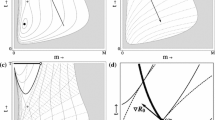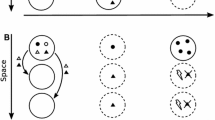Abstract
TRADE-OFFS are of fundamental importance in population biology. They prevent the evolution of a darwinian demon (a species that breeds fast, lives long and is both a good competitor and disperser) and result in the wide range of life histories we observe in nature1. Trade-offs are also thought to be important in ecology, driving successional change and maintaining species diversity2,3. But the demonstration of trade-offs is difficult4,5. Evolutionary theory predicts trade-offs between seed dormancy and (1) seed weight6 and (2) seed spatial dispersal6,7. Here we present simulation results predicting a third trade-off between seed dormancy and adult longevity. The existence of these trade-offs is tested, to our knowledge for the first time, using modern comparative methods8,9 and data from long-term experiments10& ndash;12. The analyses are consistent with the existence of all three trade-offs in nature.
Similar content being viewed by others
References
Law, R. in Population Dynamics (eds Anderson, R. M., Turner, B. D. & Taylor, L. R.) 81–103 (Blackwell, Oxford, 1979).
Tilman, D. Resource Competition and Community Structure (Princeton Univ. Press, Princeton, 1982).
Shmida, A. & Ellner, S. Vegetatio 58, 29–55 (1984).
Partridge, L. & Sibly, R. in The Evolution of Reproductive Strategies (eds Harvey, P. H., Partridge, L. & Southwood, T. R. E.) 3–13 (Royal Society, London, 1991).
Maynard Smith, J. in The Evolution of Reproductive Strategies (eds Harvey, P. H., Partridge, L. & Southwood, T. R. E.) 103–104 (Royal Society, London, 1991).
Venable, D. L. & Brown, J. S. Am. Nat. 131, 360–384 (1988).
Bulmer, M. G. Theor. pop. Biol. 26, 376–377 (1984).
Harvey, P. H. & Pagel, The Comparative Method in Evolutionary Biology (Oxford Univ. Press, Oxford, 1991).
Purvis, A. Comparative Analysis by Independent Contrasts, version 1.2: User's Guide (Oxford University, Oxford, 1991).
Roberts, H. A. Weed Research 4, 296–307 (1964).
Roberts, H. A. J. appl. Ecol. 16, 195–201 (1979).
Roberts, H. A. & Boddrell, J. E. Ann. appl. Biol. 103, 301–309 (1983).
Cohen, D. J. theor. Biol. 12, 110–129 (1966).
Cohen, D. & Levin, S. A. Theor. pop. Biol. 39, 63–99 (1991).
Bulmer, M. G. Am. Nat. 126, 63–71 (1985).
Lokesha, R., Hedge, S. G., Uma Shaanker, R. & Gneshaiah, K. N. Am. Nat. 140, 520–525 (1992).
Ellner, S. J. theor. Biol. 123, 173–185 (1986).
Stebbins, G. L. Variation and Evolution in Plants (Columbia Univ. Press, London, 1950).
Cook, R. in Demography and Evolution in Plant Populations (ed. Solbrig, O. T.) 107–129 (Blackwell, Oxford, 1980).
Thompson, K. New Phytol. 106, 23–34 (1987).
Fenner, M. in Colonisation, Succession and Stability (eds Gray, A. J., Crawley, M. J. & Edwards, P. J.) 103–114 (Blackwell, Oxford, 1987).
Waller, D. M. in Plant Reproductive Ecology: Patterns and Strategies (eds Lovett Doust, J. & Lovett Doust, L.) 203–227 (Oxford Univ. Press, Oxford, 1988).
Fenner, M. Seed Ecology (Chapman & Hall, London, 1985).
Parker, V. T. & Kelly, V. R. in Ecology of Soil Seed Banks (eds Leck, M. A., Parker, V. T. & Simpson, R. L.) 231–255 (Academic, London, 1989).
Rees, M. & Long, M. J. Am. Nat. 141, 233–262 (1993).
Grime, J. P., Hodgson, J. G. & Hunt, R. Comparative Plant Ecology: a Functional Approach to Common British Species (Unwin Hyman, London, 1988).
Clapham, A. R., Tutin, T. G. & Moore, D. M. Flora of the British Isles (Cambridge Univ. Press, Cambridge, 1989).
Baskin, C. C. & Baskin, J. M. Am. J. Bot. 75, 286–305.
Metz, J. A. J., Nisbet, R. M. & Geritz, S. A. H. Trends Ecol. Evol. 7, 198–202 (1992).
Rees, M. Am. Nat. (in the press).
Author information
Authors and Affiliations
Rights and permissions
About this article
Cite this article
Rees, M. Trade-offs among dispersal strategies in British plants. Nature 366, 150–152 (1993). https://doi.org/10.1038/366150a0
Received:
Accepted:
Issue Date:
DOI: https://doi.org/10.1038/366150a0
- Springer Nature Limited
This article is cited by
-
Carboxylate-releasing Eucalyptus patens in a low-diversity spot in a biodiversity hotspot in Southwest Australia is not a ‘Darwinian demon’
Plant and Soil (2023)
-
Understanding the drivers of dispersal evolution in range expansions and their ecological consequences
Evolutionary Ecology (2022)
-
Seed banks in urban vacant lots of a Latin American megacity are easily germinable and strongly dominated by exotic flora
Urban Ecosystems (2020)
-
Seed germination of gynodioecious species: theoretical considerations and a comparison of females and hermaphrodites
Planta (2020)
-
Testing the competition-colonization trade-off and its correlations with functional trait variations among subtropical tree species
Scientific Reports (2019)





